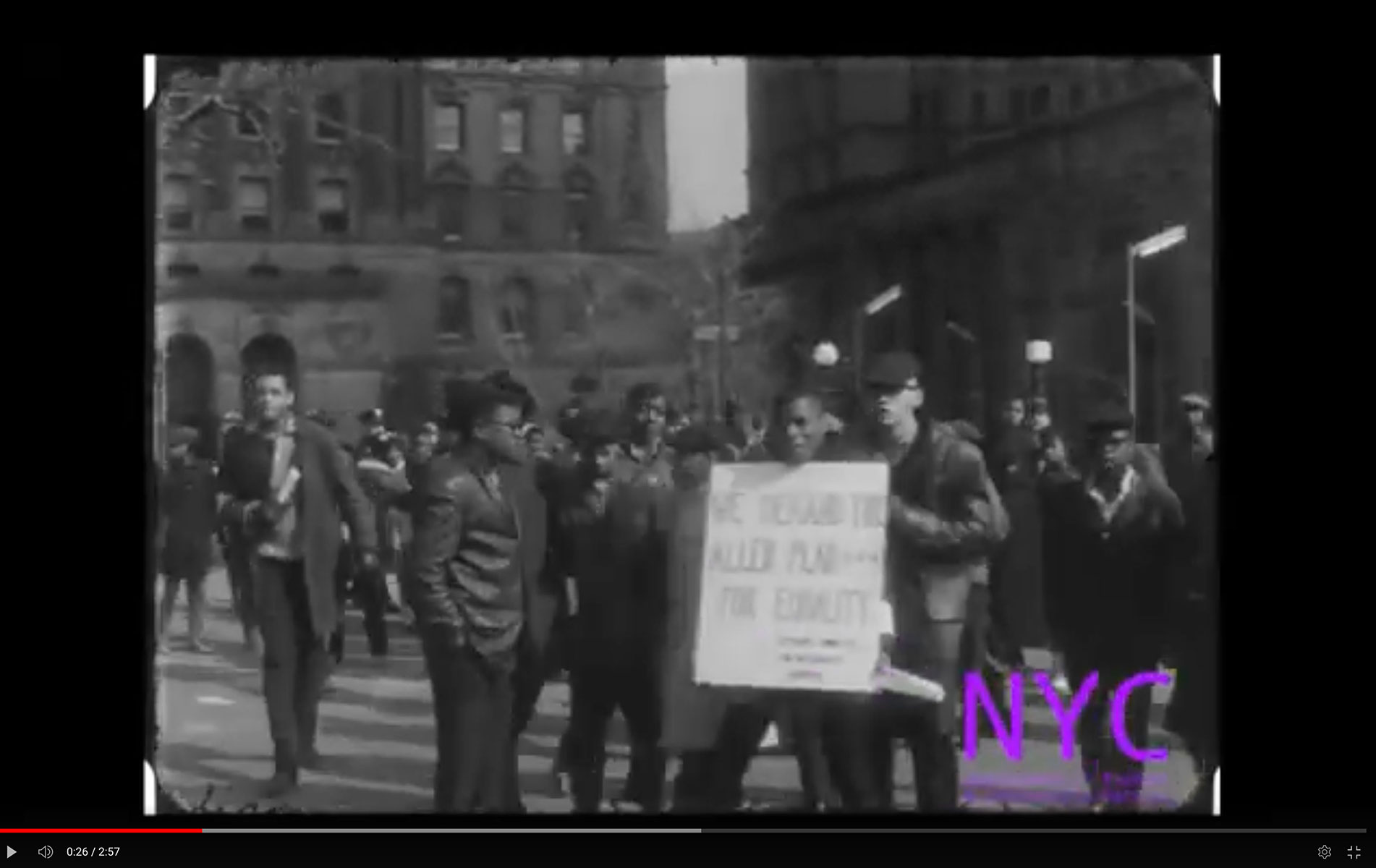You are here:
The 1965 Boycott on Film

Date: 1965
Caption: The New York Police Department filmed a 1965 protest for integrated schools. The date suggests that this footage comes from the 1965 boycott of junior high schools and “600” schools.
The 1965 boycott targeted segregation in New York City’s junior high schools and “600” schools. But for 2000 students - primarily Black and Puerto Rican boys - who attended the “600” day schools, those schools were places they were sent because they were labeled by the schools as “socially maladjusted” or “emotionally disturbed.” Some of the students had been ordered to attend these schools after interactions with the police and the juvenile legal system. Most students did not find a supportive educational environment there, and those who had disabilities did not receive the support they needed.
This protest for school desegregation, in front of the Board of Education headquarters in Brooklyn, may have involved students from the “600” schools who were participating in the boycott as well as from other participating junior high schools.
This footage provides us a record of what one protest related to the 1965 boycott looked like. But it was not created for this purpose. According to the New York City Municipal Archives, this footage was recorded as part of the New York City Police Department’s surveillance program. “Throughout the 20th century, the New York City Police Department (NYPD) conducted overt [or visible] and covert [or hidden] surveillance on groups and individuals identified as potential security threats to the City… The subjects include a broad range of political activist groups and events from 1960 to 1980.”1 That “broad range” includes many activists of color who were challenging racism and other kinds of injustice. The NYPD filmed protests against police brutality, against the Vietnam War, against racism in hiring construction workers, and more. The police perceived the activists at these protests, including the school boycotters, as “potential security threats.” That is one example of how Black and Latinx people, and those white people in solidarity with them, have been “criminalized” - or understood as criminals - in the US.2 This criminalization was frequently experienced by Black and Puerto Rican boys who were labeled as “maladjusted” or “delinquent” - terms that mixed racism, ableism, and criminalization - and then assigned to “600” schools.3
-
NYPD Surveillance Films, NYC Municipal Archives Collection, New York City Departments of Records and Information Services, accessed February 7, 2023, https://nycma.lunaimaging.com/luna/servlet/NYCMA
33. ↩︎ -
Elizabeth Hinton, From the War on Poverty to the War on Crime: The Making of Mass Incarceration in America (Cambridge, MA: Harvard University Press, 2016). ↩︎
-
Francine Almash, “New York City ‘600’ Schools and the Legacy of Segregation in Special Education,” The Gotham Center for New York City History, June 21, 2022, https://www.gothamcenter.org/blog/new-york-city-600-schools-and-the-legacy-of-segregation-in-special-education. ↩︎
Categories: K-12 organizing, special education, Brooklyn, student activism, parent activism
Tags: protest, organizing, racist segregation, policing and the criminal legal system, disability labels, emotional disabilities, Disabled people, photography, imagery, and visual representation, Black people, Latinx people
This item is part of "The Less-Known 1965 Boycott" in "Boycotting New York’s Segregated Schools"
Item Details
Date: 1965
Creator: New York Police Department Surveillance Unit
Source: Municipal Archives of the City of New York, NYPD Surveillance Films
Copyright: Under copyright. Courtesy of the Municipal Archives of the City of New York
How to cite: “The 1965 Boycott on Film,” New York Police Department Surveillance Unit, in New York City Civil Rights History Project, Accessed: [Month Day, Year], https://nyccivilrightshistory.org/gallery/the-1965-boycott.
Questions to Consider
- How do you think the young people in this film felt about participating in this protest? What evidence can you find in the film footage? How do you think they felt about protesting school segregation at junior high and “600” schools?
- What difference does it make, to you as a viewer, to know that this footage was recorded by the New York Police Department? How does that affect what we can learn from it? How do you think the participating students and adults would have felt, if they knew they were being recorded by the police?
References
How to Print this Page
- Press Ctrl + P or Cmd + P to open the print dialogue window.
- Under settings, choose "display headers and footers" if you want to print page numbers and the web address.
- Embedded PDF files will not print as part of the page. For best printing results, download the PDF and print from Adobe Reader or Preview.
